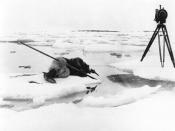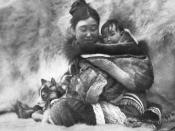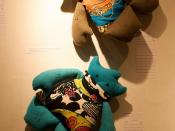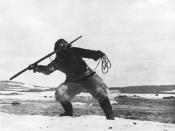Reality is often mistaken. What we think is one way may in fact be another, and our perceptions of "what is" are usually clouded by the half-truths that are presented to us. However, this is not as bad as it seems. Robert Flaherty, the creator of the film "Nanook of the North," says that, "One often has to distort a thing in order to catch its true spirit (Rony, p. 116)." This statement was true 80 years ago, and it still holds true today. It is impossible for filmmakers to be everywhere at once, and therefor narrations that follow real events will always be missing certain parts. The solution to these gaps is often solved by the re-enactment of scenes at a later date. Despite the alteration to reality, re-enacted material is often a necessary and important part of many documentaries.
"The authenticity of [a documentary] ultimately depends entirely on the honesty of the director, who, through his work, asserts that 'This is what I saw' (p.
116)." About a year ago Mark Burnett, the creator of the hit show "Survivor," announced that he sometimes re-enacted scenes in order to get better camera angles. None of the re-enactments affected the outcome of the contests or the show itself, they were done simply because the desired shots just weren't able to be recorded at the time. Viewers benefit from this half-truth because they are given more perspective on the entire event. This same sort of thing happened in the film "Nanook of the North." Somewhere around the middle of the film, Flaherty shows footage of the Eskimos he was following carrying out tasks inside one of the igloos they had created (Flaherty, 1922). This scene was obviously re-enacted, for there wouldn't have been enough light in the actual location at the time, and one can even spot the edges of the poorly made set when the camera pans off-center for a second. Without these images however, the viewer would be clueless as to exactly what was going on inside of the igloo. The extra information, although falsely represented as being real, is true to the actual events that took place. These additions do not create a sense of fakeness at all, but instead add a wholeness to the overall feeling of the film (Rony, p. 114-116).
Robert Flaherty says that, "There's a saying among prospectors: 'Go out looking for one thing, and that's all you'll ever find.'" If it is not possible to record the story as it is unfolding, it is perfectly alright for a director to shoot re-enactments at a later time, so long as special attention is given to the reality of the actual event. Without re-enactments, shows such as "Nanook of the North" and "Survivor" would be incomplete. The final goal that any documentor should never lose sight of is to find the story that already exists in the life of the people and then to simply record it (p. 118).
Reality is often distorted in order to tell the truth. Fortunately, this distortion is often beneficial to viewer. The whole truth isn't always totally accessible, and a director can perform the amazing task of showing us what we normally wouldn't be able to see. Without the fake, there would be no real.




